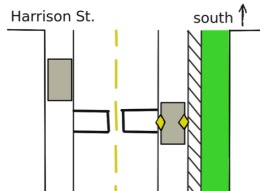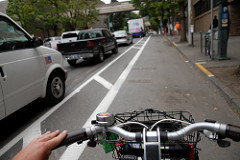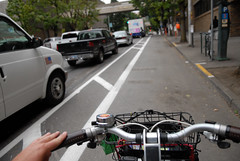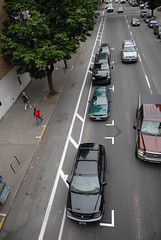An ongoing research project by the Department of Environmental Science at Portland State University is taking a closer look at how separated bicycle infrastructure (like cycle tracks) impacts the air quality and health of road users.
The goal of the research team was to determine the amount of ultrafine particulate matter from motor vehicle emissions that were inhaled by people riding on standard bike lanes (with cars directly adjacent) compared with people riding on cycle tracks (separated from moving cars, like the one on SW Broadway near PSU).

parked car and the yellow diamonds
are where the P-trak instruments
were located.
Air quality levels were measured by ultrafine particle counters (known as P-trak instruments) that were attached to the rear-view mirrors of a car parked in the parking zone that separates the bikeway from the other traffic lanes on SW Broadway. With this set-up, exposure levels measured on the driver’s side were akin to what a person would be exposed to riding in a traditional bike lane and the exposure levels measured on the passenger side represented the exposure while riding in a cycle track.
The results show “statistically significant differences” in exposure levels and a correlation between those differences in exposure with traffic levels (which were also measured). The study concluded that the parked cars did not act as the main barrier to the ultrafine particulate matter and instead they found that lower levels were due to the “increased horizontal distance from the traffic stream.”

Here are the key takeaways excerpted from the paper’s conclusion:
“Traffic measurements showed the exposure concentration differences to be greatest at times of highest traffic volumes, emphasizing the importance of mitigation techniques in areas with simultaneously high volumes of motor vehicle and bicycle commuters…
The findings of this study show a cycle track roadway design may be more protective for cyclists than a traditional bicycle lane in terms of lowering exposure concentrations of ultrafine particles… Based on these initial findings, understanding roadway and traffic effects on exposure levels can help guide bicycle facility design and pinpoint locations in which mitigation of exposure levels by placement of facilities such as cycle tracks may be most important.”
The paper, The Impact of Bicycle Characteristics on Bicyclists Exposure to Traffic-Related Particulate Matter, was accepted by the Transportation Research Board and is slated to be presented at their annual conference in Washington D.C. this January.
Authors of the paper were Christine M. Kendrick, Adam Moore, Ashley Haire, Alexander Bigazzi, Miguel Figliozzi, Christopher M. Monsere, and Linda George. The paper was funded the Miller Grant Foundation and the Oregon Transportation Research and Education Consortium (OTREC).



